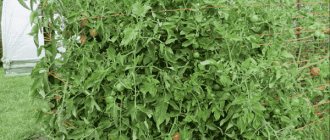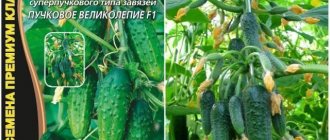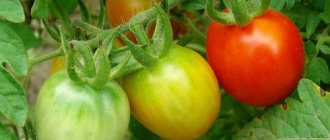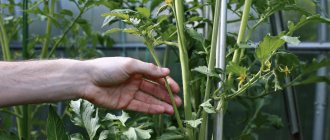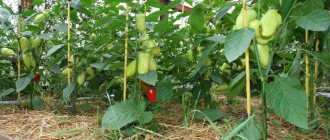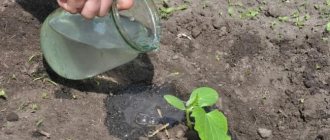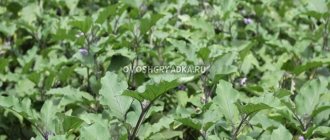» Vegetable growing » Tomatoes » Tomato variety Gina
0
11107
Article rating
When choosing tomato seedlings, everyone strives to choose a high-yielding, unpretentious and disease-resistant variety. These requirements are fully met by the Dutch tomato variety Gina.
- Advantages and disadvantages
- Sowing seeds
- Care
- Advantages of this method
- Planting through seedlings
- Care
- Planting in open ground
- Care
- Plant varieties
- Reviews from gardeners
Tomato variety Gina
general characteristics
The Gina tomato variety was selected not very long ago, but has already managed to gain wide popularity. Designed for cultivation in open ground, in greenhouses and greenhouses.
Description of fruits and bush
The plant is low-growing, the bush is spreading, medium-leaved, the height is 40 - 60 cm, and has three thick stems growing from the root. It is advisable to tie up the bush during the fruiting period. Does not require stepsoning.
The tomatoes are slightly ribbed, round, slightly flattened near the stalk. They are quite large (180 - 250 g), of the same size, bright red, with thick skin, so they are perfectly stored and transported.
The pulp is pink, juicy, fleshy. Tomatoes are tasty, sweetish, universally used - suitable for both fresh consumption and processing. Not entirely suitable for preservation, because... The fruits are large and do not always fit into the jar.
Productivity
Fruiting is extended: from the moment of emergence to the first harvest, 100 - 120 days pass, but this is compensated by a good level of productivity. Average value with proper agricultural technology: 10 kg/m².
2 - 2.5 kg of tomatoes are harvested from one bush.
The fruits grow in clusters, 3-5 pieces each. on each one. The first brush appears after the 8th sheet, then every two sheets.
Pests
The Gina tomato variety is resistant to various diseases, but it is often attacked by pests:
- Colorado potato beetle - for control, use the preparations Confidor (1 ampoule per bucket of water), Corado (1 ampoule per 1 liter of water, stir and add the amount of liquid required according to the instructions);
- aphids - spray with Ratibor, Konfidor, Corado (description of method of application according to the instructions);
- mole cricket - afraid of the drug Medvetox (place 30 g of granules in a bag around the perimeter of the beds, water generously);
- wireworm - Zemlin, Bazudin are used for destruction (granules are distributed over the beds so that they become food for pests).
():
The drug Bazudin has a high hazard class. In the year of its use, it is not recommended to plant anything in the area where Bazudin granules were spread.
Diseases and pests
Judging by the description, Gina’s tomato almost does not suffer from nightshade diseases. It can receive the greatest damage from pests - aphids, Colorado potato beetles and mole crickets.
- Aphids are insects that feed on plant sap. Because of this, tomatoes stop growing, blooming and setting fruit. Aphids also transmit viral and fungal diseases. The chemicals Biotlin, Askarin and Iskra help fight the pest. As preventative measures, you can burn plant remains, dig up the soil in the fall and treat it with karbofos in the spring.
Otherwise, there are no particular problems with growing Gina tomatoes.
Advantages and disadvantages
The positive characteristics of Gina tomatoes are as follows:
- resistance to typical diseases: fusarium wilt, root rot, late blight;
- high productivity;
- large-fruited.
The variety has good yield
The disadvantages are:
- sensitivity to temperature fluctuations (even at 15° the bushes may stop growing and begin to hurt);
- plants grow greatly;
- The fruits are large and heavy, which can cause the stems to break.
Description of Gina tomatoes or commercial break
Some manufacturers indicate different ripening times.
Basically, 115-125 days pass before the first fruits appear. This variety is distinguished by the average branching of the bush, which reaches 35-60 cm in height (sometimes stretches up to 80 cm). Since the vegetable crop is determinate, it is not pinched or tied up. Other unique characteristics of Gin tomatoes include:
- possibility of growing by seedlings and seed methods;
- high resistance to fusarium and verticillium;
- unprecedented yield - 10 kg/m²;
- crack resistance.
The weight of the first fruits is often about 250-350 g. On average, the weight of specimens varies from 150 to 210 g.
The fruits are quite dense and fleshy, so they are perfect for transportation and canning. Despite their round shape, tomatoes are slightly flattened and resemble an ellipse. Their surface is smooth with slight ribbing in the tail area. The pulp is very aromatic and tasty. Since there is practically no core, the variety is used in salads and for making tomato paste. The color of the fruit is often deep red.
The Gin TST hybrid, adapted for breeding in all territories of the Russian Federation, is smaller in size (up to 200 g) and has a red-orange color. Productivity - 6 kg/m².
Sowing seeds
According to the description of the Gina variety, tomatoes can be grown without seedlings, but this is done exclusively in the southern zones.
Sow in the ground in the southern regions in mid-late April. The seed material is pre-soaked in a weak solution of potassium permanganate for disinfection.
():
When grown without seedlings, early ripening tomato varieties, including Gina, begin to bear fruit in the southern regions in mid-August. In more northern regions, sowing seeds in open ground is possible no earlier than mid-May, and fruiting will begin in the second ten days of September.
The area intended for sowing should be in a bright, windless place, with well-drained soil (tomatoes do not like stagnant water). The soil temperature should be 15 - 17º C.
Step-by-step instruction:
- prepare the furrows (distance between rows 50 - 60 cm);
- add wood ash and potassium-phosphorus fertilizers to the soil, cover it with regular soil from the garden;
- Water the furrows well;
- form shallow holes (every 25 - 30 cm), put 3 - 4 pieces in each. seeds;
- cover with soil;
- install the arcs and cover the area with film.
Care
After about 6 - 10 days, the first shoots will appear. You need to leave one plant in the hole and remove the rest.
After the formation of the first two leaves, the first feeding is carried out: dilute 1.5 g of ammonium nitrate in 1 liter of water, pour 0.5 liter of the composition into each well.
The second feeding is carried out after the appearance of the ovary: at a distance of 15 - 20 cm from the root, grooves are made with a depth of 7 cm, superphosphate and potassium are poured into them (the method of application is on the package).
Advantages of this method
It is possible to use varietal material from independently grown fruits.
():
The seedless method is the most cost-effective. There is no need to purchase soil and containers for sowing, or to additionally illuminate the seedlings using electricity.
Tomatoes grown without seedlings require less watering. Their root system is not damaged during transplantation. The plant can partially provide itself with moisture, so it requires moderate watering.
The disadvantage is the later appearance of fruits.
General description of the Gina variety and recommended growing regions
The Gina tomato is a mid-early variety bred by Dutch breeders. The first fruits begin to ripen just 3.5–4 months after the appearance of the first shoots. The bush is compact, rarely exceeding half a meter in height. Requires garter - shoots cannot support the weight of tomatoes.
The variety has a number of advantages noted by gardeners:
- excellent taste of the fruit;
- versatility (it is recommended to use tomatoes for long-term storage and preservation);
- unpretentiousness;
- ease of cultivation;
- resistance to diseases;
- increased productivity.
The variety is often confused with tomatoes that have a similar name - Gina TST. This tomato was bred in Russia and differs in size, fruit color, and characteristics (tomatoes have thin skin, so they are not suitable for storage or canning).
Expert opinion
Stanislav Pavlovich
Gardener with 17 years of experience and our expert
Ask a Question
Important! It is recommended to grow Gina in regions with warm or temperate climates. The plant can easily withstand unfavorable conditions, but may die if there are sudden temperature fluctuations. For gardeners living in the northern regions, it is better to use a greenhouse to grow tomatoes - this will save the bushes from death.
Planting through seedlings
You can sow seeds for seedlings from mid-March to early April.
You need to prepare the soil in advance. You can use store-bought or take it from the garden and mix it with humus in a 1:1 ratio.
Seedlings must be watered with warm water
It is recommended to populate the soil with beneficial bacteria: water with a solution of “Fitosporin” (2 tablespoons of concentrate per 10 liters of water).
The seeds are kept in a weak solution of potassium permanganate for several minutes and sown. If you germinate them in advance, the shoots will appear a few days earlier.
Tomatoes are sown in prepared soil to a depth of approximately 0.5 cm, row spacing 4 cm wide. For germination, a temperature of 20 - 22ºC during the day, and 16 - 18ºC at night is required. Water as it dries. After 7 - 10 days, the first shoots will appear.
When the first two true leaves appear, the seedlings can be transplanted from a common box into a separate cup.
Care
To prevent sprouts from stretching, you need to monitor the lighting and turn the cups with seedlings in a timely manner.
Warm, settled water is used for irrigation.
Once every two weeks it is necessary to fertilize with nitrogen-containing fertilizers - urea or saltpeter (1 tablespoon per 10 liters of water).
It is possible to use organic fertilizers or special mixtures for seedlings - Agricola, Fertika Lux (description of use in the instructions).
Two weeks before planting in open ground, the seedlings are hardened off. Start with 15 minutes outdoors, gradually increase to 1-3 hours.
They are planted in greenhouses in mid-May, in open ground in mid-June, at a soil temperature of 18ºC. Seedlings aged 55 - 60 days should have 5 - 7 true leaves and strong, thick, low stems.
Features of cultivation
Some seed producers claim that the variety is mid-season. Others write about the early harvest. For different climatic conditions, ripening times can range from 85 to 120 days. When grown in greenhouses, ripening will also be early.
It is recommended to grow these tomatoes in seedlings. The optimal time for sowing seeds for seedlings will be the end of March.
Read about all possible methods of growing tomato seedlings in the articles on our website:
- growing in twists;
- in two roots;
- in peat tablets;
- without picking;
- using Chinese technology;
- in bottles;
- in peat pots;
- without land.
The plant is sensitive to low temperatures , so the bushes are placed in a permanent place only after the soil has completely warmed up, in early or mid-June.
Per sq. m place 3-4 plants. Until they get stronger, it is advisable to use a temporary garter to the support. There is no need to plant or form a bush. When growing in the southern regions, it is recommended to do without a garter so that the bushes with fruits lie on the ground. This can protect the roots from drying out.
Caring for this tomato is simple: watering, loosening the soil, fertilizing, weeding. The first mandatory feeding of seedlings is carried out 2 weeks after planting in a permanent place. After 10 days, the procedure is repeated. The third feeding - after another 2 weeks, and after 20 days - the fourth.
Read useful articles about fertilizers for tomatoes:
- Organic, mineral, phosphorus, complex and ready-made fertilizers for seedlings and the TOP best.
- Yeast, iodine, ammonia, hydrogen peroxide, ash, boric acid.
- What is foliar feeding and when picking, how to carry it out.
During flowering, water the bushes about 2 times a week. Watering is increased during the period of fruit ripening.
Planting in open ground
Select a well-lit area protected from the wind.
The best predecessors of tomatoes: cabbage, onions, cucumbers. It should not be planted in an area where nightshades (potatoes, eggplants) previously grew; there is a high risk of pest infestation.
Plant 5-7 plants per m², planting pattern: 40x50 cm.
What should be done:
- dig up the area;
- add humus (1 bucket) or wood ash (0.5 kg) per square meter;
- It is strictly forbidden to introduce fresh manure or bird droppings; bushes grow on such organic matter, but do not bear fruit;
- dig a hole the size of the root; it is better to deepen the plant stem to the first true leaf, because the tomato will be able to sprout new roots;
- pour plenty of warm, settled water.
Care
Standard care consists of regular watering twice a week (2 liters of water for each plant), weeding after each watering, and fertilizing with potassium-phosphorus fertilizers twice a month.
Root and foliar feeding alternate, but with the appearance of the ovary, only option 2 is used. The garter is carried out once a season, before fruiting begins.
Rules for caring for crops
Fruiting largely depends on compliance with the rules of agricultural technology. Timely moistening of the soil, weeding, and application of nutrients will increase productivity and eliminate crop diseases.
Watering mode
Gina loves moderately moist soil, so do not over-water. Excess moisture will affect the taste of the fruit and increase the risk of tomato infection with fungal diseases. Watering is carried out once a week, abundantly moistening the soil with water standing in the sun.
Weeding
Be sure to promptly remove weeds. Weeds actively absorb moisture and nutrients, which will immediately affect the condition of Gina’s bushes. At the same time, loosen the soil, allowing the root system to receive the required amount of oxygen and moisture.
Mulching
Mulching will help reduce the amount of weeding and watering. A layer of sawdust, compost, and peat will also protect the tomato root system from hot sunlight and hypothermia. After each weeding, replenish the mulch (the layer should not exceed 3–5 cm).
Top dressing
For good growth, development, and fruiting, Gina will have to carry out timely feeding. It is allowed to use purchased fertilizers and homemade solutions. The main thing is not to overdo it; an excess of some elements is no less dangerous for tomatoes than their shortage.
First
The first application of fertilizers is carried out simultaneously with planting seedlings or sending seeds into the holes - wood ash (15–20 g) is added. It is allowed to add a small amount of superphosphate (up to 15 g).
Second
It is carried out 2–3 weeks after the first application of the nutrient mixture. Use a complex fertilizer or solution with a high nitrogen content.
Third
Apply during the flowering period of Gina. A solution of boric acid is often used to prevent the ovary from falling off. Per liter of water – 1 g of the drug.
Fourth
Apply two weeks after the appearance of the ovary. Complex formulations are used to provide tomato bushes with the necessary elements. It is allowed to use homemade fertilizer - fermented green mass of weeds.
Preventative treatments
Despite the durability of the Gina variety, it is better not to neglect preventive treatments. Periodic use of chemicals and homemade solutions will increase productivity and protect tomato bushes from pests and diseases.
"Agate"
The drug is recommended to be used to increase the immunity of the Gina tomato. It is allowed to treat seeds - this will reduce the risk of seedlings being damaged by blackleg.
See also: Nuances of growing, characteristics and description of tomato Mushroom basket
"Ridomil"
A product for protecting crops from rot and fungal diseases. Apply during the growing season; do not use before harvesting.
"Quadris"
Used to protect adult bushes from late blight. It is especially recommended to use in rainy summers, under unfavorable growing conditions. For late blight disease, the drug is ineffective.
"Acrobat"
A fungicide used for all tomato diseases. Acrobat solution is especially useful for late blight. It is recommended to use for prevention and treatment of bushes.
"Fundazol"
Used against fungal diseases of tomatoes. Against fusarium you will have to carry out 2 treatments, against fungi - up to 3 sprayings of bushes. Allowed to be used for soaking seeds.
"Spark"
It is recommended to use against insects that eat tomato leaves (Colorado beetle, aphids, leaf flea beetle). The product has a double effect - in addition to killing pests, it triggers the regeneration of bushes.
"Karate"
“Karate” treatments are carried out against pests infesting bushes. Use for preventive purposes at least twice a season.
"Fitoverm"
Biological agent for the destruction or prevention of thrips, aphids, and mites. The last treatment of Gina is allowed 7-10 days before harvesting tomatoes.
"Proteus"
Use against pests. For destruction and prevention, one treatment of Gina’s bushes is enough. Do not use before tomatoes ripen.
Traditional methods
Against Gina's diseases, experienced gardeners use an infusion of garlic (chop the head of the vegetable, add water - the proportions of the components are the same). Infuse for two weeks; to prepare a working solution, add 200 ml of strained infusion to a bucket of water.
Use a solution of ash and soap against tomato pests (mix 200 g of ash, 100 g of soap crumbs, boil for 10 minutes in 5 liters of water). Spraying is carried out three times at intervals of 2–3 days.
Shaping and garter
There is no need to form bushes, although staking will be needed - adult plants may not withstand the weight of the fruit. In warm regions, it is allowed to grow without support - the stems of tomatoes are located on the surface of the soil, providing the roots with coolness and protecting them from the heat.
Plant varieties
In addition to the classic Dutch tomato variety Gina, there is its Russian variety - the hybrid form “Gina TST F1”.
Tomato Gina (The best varieties of tomatoes)
tomato variety - Gina# Characteristics and description of tomato
GIN TOMATOES ARE OUT. BELL PEPPERS IN THE GREENHOUSE. VEGETABLE GARDEN IN AUGUST 2018
According to the characteristics, the fruits of the hybrid are orange in color and weigh 160 - 180 g (suitable for preservation). They ripen earlier and are resistant to cracking.
Reviews
Antonina Ivanovna
I sowed the Gina tomato directly into the ground, since I didn’t have enough time to grow it on the windowsill; this method turned out to be the most convenient. The first harvest pleased with its size. The average fruit weight reached 250 grams. Tomatoes are very tasty, with a characteristic aroma.
OlegMas
Last February I went to the store to buy seeds and they recommended the Gina variety. According to the characteristics, the tomato seemed very good, so I decided to find out whether the description matched or not. The bush has grown lush. To make it easier to collect fruit, I tied it up. The harvest turned out to be very good, the harvest lasted until October, which was very pleasing. This year I will definitely plant this variety in my garden.

